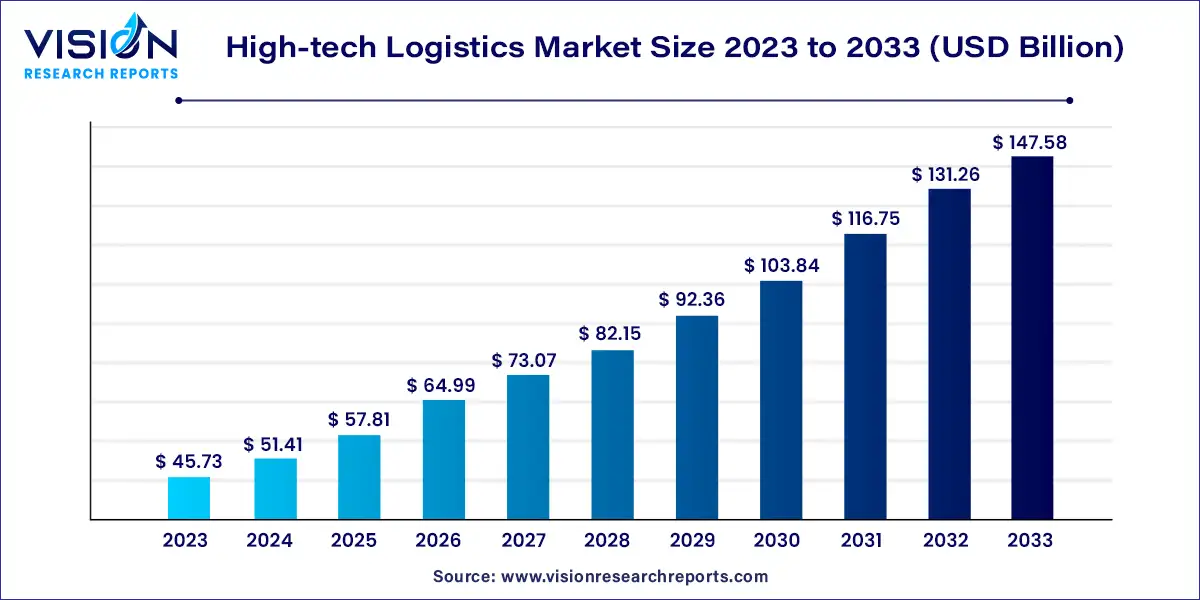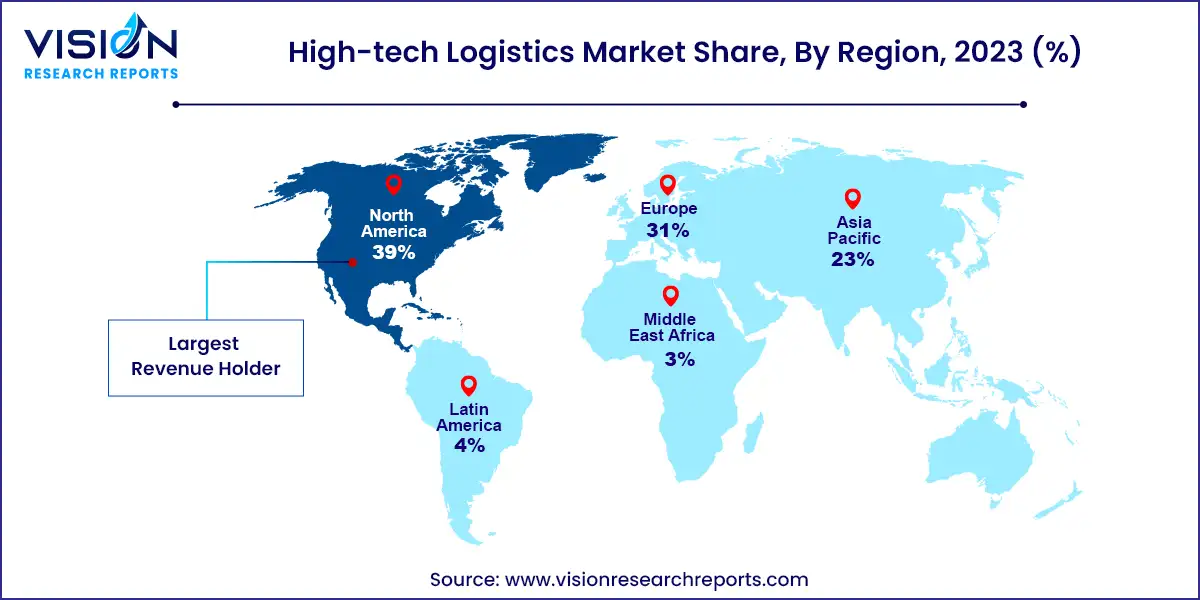The global high-tech logistics market size was estimated at around USD 45.73 billion in 2023 and it is projected to hit around USD 147.58 billion by 2033, growing at a CAGR of 12.43% from 2024 to 2033. The high-tech logistics market refers to the transportation, warehousing, and distribution services designed to handle high-value, technologically advanced products. These include electronics, semiconductors, telecommunications equipment, medical devices, and other precision instruments. Due to the sensitive nature of these products, the industry emphasizes precision, security, and efficiency, relying on cutting-edge technologies such as automation, IoT, and artificial intelligence to enhance supply chain management.

The growth of the high-tech logistics market is primarily driven by an increasing demand for efficient and secure transportation of high-value goods, such as electronics and medical devices. The rapid expansion of e-commerce, coupled with the globalization of supply chains, has created a need for more advanced logistics solutions that ensure real-time tracking and faster delivery. Additionally, the adoption of automation, artificial intelligence, and IoT in logistics operations has significantly improved efficiency and reduced human error, further accelerating market growth. Increasing investments in infrastructure development, along with the rising trend of outsourcing logistics services to third-party providers, are also contributing to the market’s expansion.
North America led the global high-tech logistics market with a 39% revenue share in 2023. The region’s strong technology sector drives demand for specialized logistics services for sensitive electronics and high-value components. The robust growth of e-commerce and consumer expectations for rapid delivery of tech products have increased the need for advanced supply chain solutions. Furthermore, the presence of major tech companies with complex global supply networks contributes to the region's leadership in the high-tech logistics market.
| Attribute | North America |
| Market Value | USD 17.83 Billion |
| Growth Rate | 12.45% CAGR |
| Projected Value | USD 57.55 Billion |
The Asia Pacific high-tech logistics market is projected to grow rapidly, with a CAGR of 13.03% from 2024 to 2033. The region’s growth is driven by its expanding technology manufacturing sector, especially in countries like China, Taiwan, and South Korea. The rising adoption of consumer electronics across emerging economies is boosting the demand for efficient distribution networks. Additionally, investments in digital infrastructure and e-commerce platforms, along with government initiatives promoting technology industries, are contributing to the region’s market expansion.

Europe’s high-tech logistics market growth is primarily driven by its emphasis on Industry 4.0 and digital transformation. The expansion of e-commerce platforms for consumer electronics is increasing the need for efficient supply chain management. Furthermore, European countries’ focus on sustainability is pushing for greener logistics practices, particularly in the high-tech sector. The rise of smart cities and IoT applications is also opening new opportunities for specialized logistics services. Strict regulations on data protection and product safety in Europe are driving the need for more secure and traceable supply chain solutions for high-value tech goods.
In 2023, the transportation segment accounted for the largest revenue share of 39% in the high-tech logistics market. This dominance is expected to continue from 2024 to 2033, driven by the need for efficient and secure transportation of high-value, sensitive technology products like semiconductors and medical devices. Advances in transportation technologies, including real-time tracking, temperature control, and specialized handling, are expected to further enhance the segment's growth, ensuring safe and timely deliveries.
The inventory management segment is projected to record the fastest compound annual growth rate (CAGR) of 13.54% between 2024 and 2033. This growth is due to the increasing complexity of high-tech product supply chains, which require advanced inventory solutions for real-time visibility, accurate stock levels, and efficient order fulfillment. The rise of automation, AI-driven analytics, and smart warehousing technologies is significantly enhancing inventory management, supporting its expansion in the high-tech logistics sector.
The semiconductor industry held the largest revenue share of 33% in the global high-tech logistics market in 2023. The complexity and global nature of the semiconductor supply chain, which spans multiple countries, drive the demand for specialized logistics solutions. This industry’s high-value products require secure, temperature-controlled, and time-sensitive transportation. The global chip shortage has also increased the emphasis on efficient logistics to meet the rising demand across various technology sectors.
The consumer electronics segment is expected to register the fastest CAGR of 12.94% from 2024 to 2033. This growth is primarily driven by the increasing global demand for smartphones, smart home devices, and wearables, which is creating a need for efficient distribution networks. The frequent launches of new products and shorter product lifecycles require agile supply chains for rapid market deployment. Additionally, the growth of e-commerce and direct-to-consumer sales models is boosting demand for streamlined last-mile delivery solutions.
By Service
By Industry
By Region
Chapter 1. Introduction
1.1. Research Objective
1.2. Scope of the Study
1.3. Definition
Chapter 2. Research Methodology
2.1. Research Approach
2.2. Data Sources
2.3. Assumptions & Limitations
Chapter 3. Executive Summary
3.1. Market Snapshot
Chapter 4. Market Variables and Scope
4.1. Introduction
4.2. Market Classification and Scope
4.3. Industry Value Chain Analysis
4.3.1. Raw Material Procurement Analysis
4.3.2. Sales and Distribution Channel Analysis
4.3.3. Downstream Buyer Analysis
Chapter 5. COVID 19 Impact on High-tech Logistics Market
5.1. COVID-19 Landscape: High-tech Logistics Industry Impact
5.2. COVID 19 - Impact Assessment for the Industry
5.3. COVID 19 Impact: Global Major Government Policy
5.4. Market Trends and Opportunities in the COVID-19 Landscape
Chapter 6. Market Dynamics Analysis and Trends
6.1. Market Dynamics
6.1.1. Market Drivers
6.1.2. Market Restraints
6.1.3. Market Opportunities
6.2. Porter’s Five Forces Analysis
6.2.1. Bargaining power of suppliers
6.2.2. Bargaining power of buyers
6.2.3. Threat of substitute
6.2.4. Threat of new entrants
6.2.5. Degree of competition
Chapter 7. Competitive Landscape
7.1.1. Company Market Share/Positioning Analysis
7.1.2. Key Strategies Adopted by Players
7.1.3. Vendor Landscape
7.1.3.1. List of Suppliers
7.1.3.2. List of Buyers
Chapter 8. Global High-tech Logistics Market, By Service
8.1. High-tech Logistics Market, by Service, 2024-2033
8.1.1. Transportation
8.1.1.1. Market Revenue and Forecast (2021-2033)
8.1.2. Warehousing and Storage
8.1.2.1. Market Revenue and Forecast (2021-2033)
8.1.3. Inventory Management
8.1.3.1. Market Revenue and Forecast (2021-2033)
8.1.4. Distribution and Fulfillment
8.1.4.1. Market Revenue and Forecast (2021-2033)
Chapter 9. Global High-tech Logistics Market, By Industry
9.1. High-tech Logistics Market, by Industry, 2024-2033
9.1.1. Semiconductor Industry
9.1.1.1. Market Revenue and Forecast (2021-2033)
9.1.2. Consumer Electronics
9.1.2.1. Market Revenue and Forecast (2021-2033)
9.1.3. Medical Devices
9.1.3.1. Market Revenue and Forecast (2021-2033)
9.1.4. Telecommunications Equipment
9.1.4.1. Market Revenue and Forecast (2021-2033)
9.1.5. Aerospace and Defense Technologies
9.1.5.1. Market Revenue and Forecast (2021-2033)
Chapter 10. Global High-tech Logistics Market, Regional Estimates and Trend Forecast
10.1. North America
10.1.1. Market Revenue and Forecast, by Service (2021-2033)
10.1.2. Market Revenue and Forecast, by Industry (2021-2033)
10.1.3. U.S.
10.1.3.1. Market Revenue and Forecast, by Service (2021-2033)
10.1.3.2. Market Revenue and Forecast, by Industry (2021-2033)
10.1.4. Rest of North America
10.1.4.1. Market Revenue and Forecast, by Service (2021-2033)
10.1.4.2. Market Revenue and Forecast, by Industry (2021-2033)
10.2. Europe
10.2.1. Market Revenue and Forecast, by Service (2021-2033)
10.2.2. Market Revenue and Forecast, by Industry (2021-2033)
10.2.3. UK
10.2.3.1. Market Revenue and Forecast, by Service (2021-2033)
10.2.3.2. Market Revenue and Forecast, by Industry (2021-2033)
10.2.4. Germany
10.2.4.1. Market Revenue and Forecast, by Service (2021-2033)
10.2.4.2. Market Revenue and Forecast, by Industry (2021-2033)
10.2.5. France
10.2.5.1. Market Revenue and Forecast, by Service (2021-2033)
10.2.5.2. Market Revenue and Forecast, by Industry (2021-2033)
10.2.6. Rest of Europe
10.2.6.1. Market Revenue and Forecast, by Service (2021-2033)
10.2.6.2. Market Revenue and Forecast, by Industry (2021-2033)
10.3. APAC
10.3.1. Market Revenue and Forecast, by Service (2021-2033)
10.3.2. Market Revenue and Forecast, by Industry (2021-2033)
10.3.3. India
10.3.3.1. Market Revenue and Forecast, by Service (2021-2033)
10.3.3.2. Market Revenue and Forecast, by Industry (2021-2033)
10.3.4. China
10.3.4.1. Market Revenue and Forecast, by Service (2021-2033)
10.3.4.2. Market Revenue and Forecast, by Industry (2021-2033)
10.3.5. Japan
10.3.5.1. Market Revenue and Forecast, by Service (2021-2033)
10.3.5.2. Market Revenue and Forecast, by Industry (2021-2033)
10.3.6. Rest of APAC
10.3.6.1. Market Revenue and Forecast, by Service (2021-2033)
10.3.6.2. Market Revenue and Forecast, by Industry (2021-2033)
10.4. MEA
10.4.1. Market Revenue and Forecast, by Service (2021-2033)
10.4.2. Market Revenue and Forecast, by Industry (2021-2033)
10.4.3. GCC
10.4.3.1. Market Revenue and Forecast, by Service (2021-2033)
10.4.3.2. Market Revenue and Forecast, by Industry (2021-2033)
10.4.4. North Africa
10.4.4.1. Market Revenue and Forecast, by Service (2021-2033)
10.4.4.2. Market Revenue and Forecast, by Industry (2021-2033)
10.4.5. South Africa
10.4.5.1. Market Revenue and Forecast, by Service (2021-2033)
10.4.5.2. Market Revenue and Forecast, by Industry (2021-2033)
10.4.6. Rest of MEA
10.4.6.1. Market Revenue and Forecast, by Service (2021-2033)
10.4.6.2. Market Revenue and Forecast, by Industry (2021-2033)
10.5. Latin America
10.5.1. Market Revenue and Forecast, by Service (2021-2033)
10.5.2. Market Revenue and Forecast, by Industry (2021-2033)
10.5.3. Brazil
10.5.3.1. Market Revenue and Forecast, by Service (2021-2033)
10.5.3.2. Market Revenue and Forecast, by Industry (2021-2033)
10.5.4. Rest of LATAM
10.5.4.1. Market Revenue and Forecast, by Service (2021-2033)
10.5.4.2. Market Revenue and Forecast, by Industry (2021-2033)
Chapter 11. Company Profiles
11.1. C.H. Robinson Worldwide, Inc.
11.1.1. Company Overview
11.1.2. Product Offerings
11.1.3. Financial Performance
11.1.4. Recent Initiatives
11.2. FedEx
11.2.1. Company Overview
11.2.2. Product Offerings
11.2.3. Financial Performance
11.2.4. Recent Initiatives
11.3. Agility
11.3.1. Company Overview
11.3.2. Product Offerings
11.3.3. Financial Performance
11.3.4. Recent Initiatives
11.4. DHL Group
11.4.1. Company Overview
11.4.2. Product Offerings
11.4.3. Financial Performance
11.4.4. LTE Scientific
11.5. DB Schenker
11.5.1. Company Overview
11.5.2. Product Offerings
11.5.3. Financial Performance
11.5.4. Recent Initiatives
11.6. A.P. Moller - Maersk
11.6.1. Company Overview
11.6.2. Product Offerings
11.6.3. Financial Performance
11.6.4. Recent Initiatives
11.7. Ceva Logistics
11.7.1. Company Overview
11.7.2. Product Offerings
11.7.3. Financial Performance
11.7.4. Recent Initiatives
11.8. Kerry Logistics Network Limited
11.8.1. Company Overview
11.8.2. Product Offerings
11.8.3. Financial Performance
11.8.4. Recent Initiatives
11.9. Rhenus Group
11.9.1. Company Overview
11.9.2. Product Offerings
11.9.3. Financial Performance
11.9.4. Recent Initiatives
11.10. Aramex
11.10.1. Company Overview
11.10.2. Product Offerings
11.10.3. Financial Performance
11.10.4. Recent Initiatives
Chapter 12. Research Methodology
12.1. Primary Research
12.2. Secondary Research
12.3. Assumptions
Chapter 13. Appendix
13.1. About Us
13.2. Glossary of Terms
 Cross-segment Market Size and Analysis for
Mentioned Segments
Cross-segment Market Size and Analysis for
Mentioned Segments
 Additional Company Profiles (Upto 5 With No Cost)
Additional Company Profiles (Upto 5 With No Cost)
 Additional Countries (Apart From Mentioned Countries)
Additional Countries (Apart From Mentioned Countries)
 Country/Region-specific Report
Country/Region-specific Report
 Go To Market Strategy
Go To Market Strategy
 Region Specific Market Dynamics
Region Specific Market Dynamics Region Level Market Share
Region Level Market Share Import Export Analysis
Import Export Analysis Production Analysis
Production Analysis Others
Others